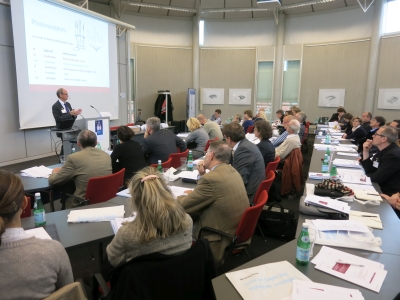Proceedings
On 13 October, the Federal Institute for Occupational Safety and Health (Bundesanstalt für Arbeitsschutz und Arbeitsmedizin, BAuA) organised a European workshop on "Light, Health and Shift Work" together with Public Health England (PHE). The workshop was attended by 70 scientists and occupational safety experts from Germany, the UK, the Netherlands, Denmark and Bulgaria, working on a broad range of topics focusing on light, health and shift work.

Many physiological processes in the human body follow the circadian rhythm of daily activity and night rest, associated with the natural pattern of daylight and darkness at night. Shift work which disrupts this normal circadian rhythm is related to a number of diseases, such as cardiovascular diseases, diabetes, or cancer. Since the discovery of a new non-visual retinal photoreceptor involved in the control of physiological processes, the influence of light on circadian rhythms is intensively investigated.
In order to better understand possible connections between health risks and shift work, field studies that measure the 24-hour personal light exposure of shift workers are of great importance. In addition to the joint BAuA-PHE project to determine the actual light exposure of shift working nurses, further field studies by European research groups were presented in the workshop. Particular attention was given to light exposure measurements and the interpretation of the measured data. Since in such field studies the chronotypes of workers, i.e. their preferred timing for sleep and wakefulness, play an important role, the methods for the determination of chronotypes in field studies were also discussed.
Furthermore, the workshop presented the results of BAuA Working Time Report Germany 2016 in relation to shift work / night shift work and discussed the challenges for epidemiological studies in data interpretation regarding the relationship between shift work and the occurrence of chronic diseases. Another BAuA study on the influence of circadian rhythms on safety at work has been presented.
In the following, selected presentations of the event are available for download.
Night- and shiftwork in Germany (PDF, 453 KB)
Anne Marit Wöhrmann, Federal Institute for Occupational Safety and Health (BAuA)
Relevance of chronotype and entrainment to shift work
Katharina Wulff, University of Oxford
Epidemiology and shift work - Chronobiological fallacies (PDF, 408 KB)
Thomas Erren, University of Cologne
Light measurements in the melanopsin age (PDF, 2 MB)
John O'Hagan, Public Health England (PHE)
Dosimetry - Making field studies comparable (PDF, 2 MB)
Luke Price, Public Health England (PHE)
Light exposure assessment of Danish indoor, outdoor and night-shift workers - Experiences from a field study (PDF, 2 MB)
Jakob Marktvart, Aalborg University, Copenhagen
Chronotype and light exposure analysis in German and UK shift-working nurses (PDF, 2 MB)
Ljiljana Udovicic (BAuA) / Luke Price (PHE)
Light measurements in an epidemiological field study
Sylvia Rabstein, Ruhr University, Bochum
Objective methods for estimating chronotype in the field (PDF, 2 MB)
Debra Skene, University of Surrey, Guildford
Influence of circadian rhythms on safety at work (PDF, 365 KB)
Jan Krüger, Federal Institute for Occupational Safety and Health (BAuA)